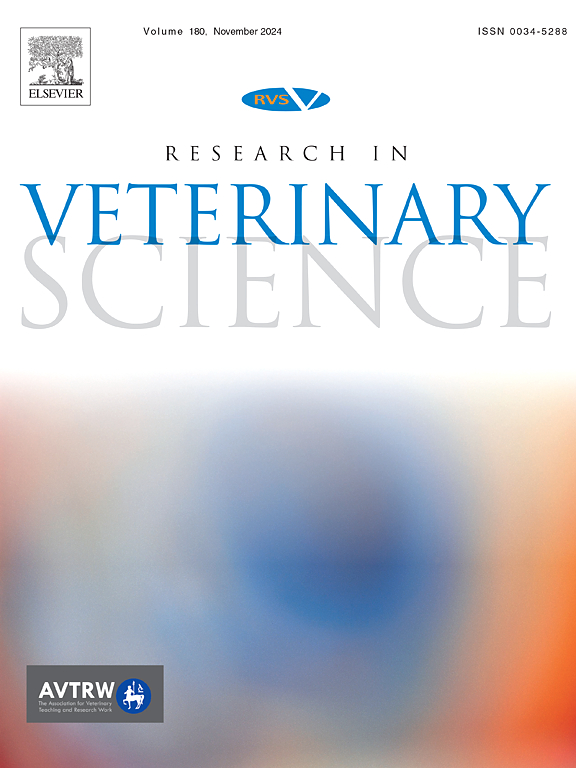Investigating compliance with cow comfort and mastitis control recommendations on mastitis outcomes in smallholder dairy farms in Central Kenya
IF 2.2
3区 农林科学
Q1 VETERINARY SCIENCES
引用次数: 0
Abstract
A randomized controlled trial was conducted in Kenya in 2020 with the objectives being to assess compliance of smallholder dairy farmers (SDF) with farm-specific mastitis and cow comfort recommendations, to determine factors associated with compliance, and to determine the impact of these recommendations in reducing cases of subclinical mastitis.
A total of 114 SDFs (124 cows) were recruited into the study and randomly allocated into intervention (74 farms) and control (40 farms) groups during the first farm visit. Existing farm-level mastitis control and cow comfort strategies were assessed in both intervention and control farms. Cow parameters (e.g. udder hygiene) were observed or measured from individual cows. A California Mastitis Test (CMT) was done on all quarters and scored from 0 (negative) to 3 (strong positive). All quarters with a CMT score of 2 and 3 were treated with intramammary antibacterial cefapirin preparation according to the label (Cefalak®). Intervention farms received farm-specific mastitis and cow comfort recommendations at the end of the first visit. On the second farm visit, cow parameters were measured again, CMT was repeated on all quarters on all cows, and compliance with recommendations was assessed and given a percentage score. Control farms were then given their farm-specific recommendations. Regression models were utilized to assess associations with compliance and improvement in CMT scores between visits.
Intervention farms received an average of 3.3 and 3.9 recommendations pertaining to mastitis control and cow comfort, respectively. Farms complied with an average of 2.8 and 2.1 mastitis and cow comfort recommendations, respectively, leading to an overall average compliance score of 63.2 % for all recommendations. On the first visit, CMT scores 1 and 2 were significantly higher in quarters among cows on the intervention than control farms. There was a significantly lower proportion of quarters with CMT scores 1 and 2 in the intervention group on the second visit than the first visit and no quarters with CMT score of 3. The principal farmer, type of recommendation and number of recommendations given were significantly associated with compliance to the recommendations. The principal farmer and their age group were significantly associated with quarter CMT scores improving between the first and second visits.
Farm-specific mastitis and cow comfort recommendations can significantly reduce the number of cases of subclinical mastitis in SDFs and should thus be included in farmers' training. Farmers should be given a small number of recommendations at a time to enhance compliance.
调查肯尼亚中部小农奶牛场遵守奶牛舒适度和乳腺炎控制建议对乳腺炎结果的影响。
2020年在肯尼亚进行了一项随机对照试验,目的是评估小农奶农(SDF)遵守农场特异性乳腺炎和奶牛舒适度建议的情况,确定与依从性相关的因素,并确定这些建议对减少亚临床乳腺炎病例的影响。研究共招募114头sdf(124头奶牛),在第一次农场访问时随机分为干预组(74个农场)和对照组(40个农场)。对干预和对照农场现有的乳腺炎控制和奶牛舒适策略进行了评估。观察或测量奶牛个体参数(如乳房卫生)。加州乳腺炎测试(CMT)在所有方面都进行了测试,得分从0(阴性)到3(强阳性)。CMT评分为2分和3分的四分之一均按照标签(Cefalak®)使用乳内抗菌头孢匹林制剂治疗。在第一次访问结束时,干预农场收到了农场特有的乳腺炎和奶牛舒适度建议。在第二次农场访问中,再次测量奶牛参数,在所有奶牛的所有部位重复CMT,并评估对建议的依从性并给出百分比分数。然后向对照农场提供具体的农场建议。使用回归模型来评估依从性与就诊间CMT评分改善的关系。干预农场在乳腺炎控制和奶牛舒适方面分别获得了平均3.3和3.9的建议。农场分别遵守了平均2.8和2.1的乳腺炎和奶牛舒适度建议,导致所有建议的总体平均遵守得分为63.2%。在第一次访问时,干预农场的奶牛的CMT得分1和2显着高于对照农场。干预组第二次就诊时CMT得分为1分和2分的院区比例明显低于第一次就诊时,没有CMT得分为3分的院区。主要的农民、建议的类型和建议的次数与建议的遵守程度显著相关。在第一次和第二次访问期间,主要农民及其年龄组与季度CMT评分的提高显著相关。农场特有的乳腺炎和奶牛舒适度建议可以显著减少sdf中亚临床乳腺炎的病例数,因此应纳入农民培训。应每次向农民提供少量建议,以提高依从性。
本文章由计算机程序翻译,如有差异,请以英文原文为准。
求助全文
约1分钟内获得全文
求助全文
来源期刊

Research in veterinary science
农林科学-兽医学
CiteScore
4.40
自引率
4.20%
发文量
312
审稿时长
75 days
期刊介绍:
Research in Veterinary Science is an International multi-disciplinary journal publishing original articles, reviews and short communications of a high scientific and ethical standard in all aspects of veterinary and biomedical research.
The primary aim of the journal is to inform veterinary and biomedical scientists of significant advances in veterinary and related research through prompt publication and dissemination. Secondly, the journal aims to provide a general multi-disciplinary forum for discussion and debate of news and issues concerning veterinary science. Thirdly, to promote the dissemination of knowledge to a broader range of professions, globally.
High quality papers on all species of animals are considered, particularly those considered to be of high scientific importance and originality, and with interdisciplinary interest. The journal encourages papers providing results that have clear implications for understanding disease pathogenesis and for the development of control measures or treatments, as well as those dealing with a comparative biomedical approach, which represents a substantial improvement to animal and human health.
Studies without a robust scientific hypothesis or that are preliminary, or of weak originality, as well as negative results, are not appropriate for the journal. Furthermore, observational approaches, case studies or field reports lacking an advancement in general knowledge do not fall within the scope of the journal.
 求助内容:
求助内容: 应助结果提醒方式:
应助结果提醒方式:


